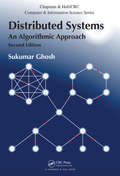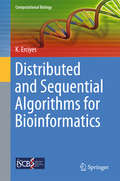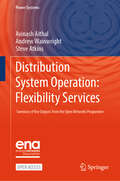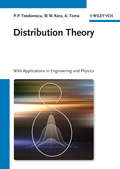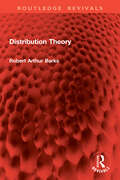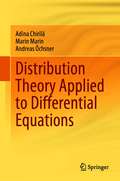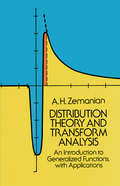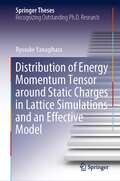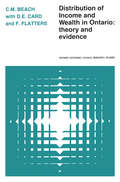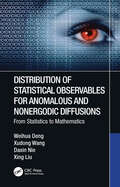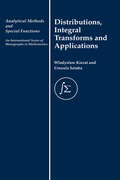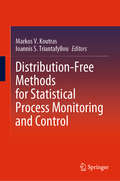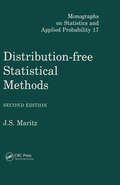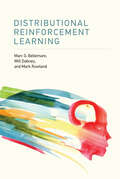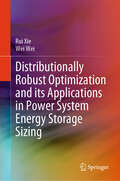- Table View
- List View
Distributed Systems: An Algorithmic Approach, Second Edition (Chapman And Hall/crc Computer And Information Science Ser.)
by Sukumar GhoshDistributed Systems: An Algorithmic Approach, Second Edition provides a balanced and straightforward treatment of the underlying theory and practical applications of distributed computing. As in the previous version, the language is kept as unobscured as possible-clarity is given priority over mathematical formalism. This easily digestible text:Fea
Distributed and Sequential Algorithms for Bioinformatics
by K. ErciyesThis unique textbook/reference presents unified coverage of bioinformatics topics relating to both biological sequences and biological networks, providing an in-depth analysis of cutting-edge distributed algorithms, as well as of relevant sequential algorithms. In addition to introducing the latest algorithms in this area, more than fifteen new distributed algorithms are also proposed. Topics and features: reviews a range of open challenges in biological sequences and networks; describes in detail both sequential and parallel/distributed algorithms for each problem; suggests approaches for distributed algorithms as possible extensions to sequential algorithms, when the distributed algorithms for the topic are scarce; proposes a number of new distributed algorithms in each chapter, to serve as potential starting points for further research; concludes each chapter with self-test exercises, a summary of the key points, a comparison of the algorithms described, and a literature review.
Distribution Modulo One and Diophantine Approximation
by Yann BugeaudThis book presents state-of-the-art research on the distribution modulo one of sequences of integral powers of real numbers and related topics. Most of the results have never before appeared in one book and many of them were proved only during the last decade. Topics covered include the distribution modulo one of the integral powers of 3/2 and the frequency of occurrence of each digit in the decimal expansion of the square root of two. The author takes a point of view from combinatorics on words and introduces a variety of techniques, including explicit constructions of normal numbers, Schmidt's games, Riesz product measures and transcendence results. With numerous exercises, the book is ideal for graduate courses on Diophantine approximation or as an introduction to distribution modulo one for non-experts. Specialists will appreciate the inclusion of over 50 open problems and the rich and comprehensive bibliography of over 700 references.
Distribution System Operation: Summary of Key Outputs From the Open Networks Programme (Power Systems)
by Avinash Aithal Andrew Wainwright Steve AtkinsThis open access book is a coherent and accessible source of knowledge on flexibility services for energy. Local flexibility services are a commercial mechanism which allows participants to be renumerated for delivering a change in their usual power use, in real time or in response to prior request from the Distribution System Operators (DSOs) to help manage network congestion. Summarising key outputs from the Energy Networks Association&’s (ENA) Open Networks Programme, the book traces the evolution of local flexibility markets from 'Proof of Concept' to 'Business as Usual'. The book presents detailed technical and organisational insights from the development of local flexibility markets, focusing on inception, standardization, simplification, and transparency in decision-making across GB DSOs and interactions with the National Energy System Operator (NESO). Readers will find valuable comparisons of implementation approaches by different network companies, highlighting technical nuances and best practices. Ideal for researchers, energy professionals, and policymakers, this book provides a critical resource for understanding the complexities and opportunities of flexibility services in energy systems. Whether you are involved in energy management, policy development, or academic research, this book offers essential insights into the future of energy flexibility and grid management.
Distribution Theory
by Petre Teodorescu Antonela Toma Wilhelm W. KecsIn this comprehensive monograph, the authors apply modern mathematical methods to the study of mechanical and physical phenomena or techniques in acoustics, optics, and electrostatics, where classical mathematical tools fail.They present a general method of approaching problems, pointing out different aspects and difficulties that may occur. With respect to the theory of distributions, only the results and the principle theorems are given as well as some mathematical results. The book also systematically deals with a large number of applications to problems of general Newtonian mechanics, as well as to problems pertaining to the mechanics of deformable solids and physics. Special attention is placed upon the introduction of corresponding mathematical models.Addressed to a wide circle of readers who use mathematical methods in their work: applied mathematicians, engineers in various branches, as well as physicists, while also benefiting students in various fields.
Distribution Theory (Routledge Revivals)
by Robert Arthur BarksFirst published in 1972, Distribution Theory follows on from the author's earlier book, Descriptive Statistics and Probability Theory, but may easily be followed by any reader who has not studied that particular book but who has gained some knowledge of numerical distributions and basic probability theory. The author has attempted to steer a middle course between those textbooks which concentrate solely on statistical calculations and those which concentrate solely on statistical theory. It is his belief that statistics is best understood through a mixture of practical numerical work and knowledge of the corresponding theory.In this book, probability distributions are shown to develop out of different physical situations that are commonly met in the physical world. The three most commonly used- the binomial, Poisson, and normal distributions- are dealt in detail, but other less commonly used distributions are also introduced. By showing the different situations to which these distributions apply, their individuality is emphasised. The author then illustrates how these probability distributions are used in sampling theory. The book concludes with a chapter which shows how apparently different parts of statistics can be seen to interrelate through statistical theory. This is an interesting reference work for students of mathematics, statistics and economics.
Distribution Theory Applied to Differential Equations
by Andreas Öchsner Marin Marin Adina ChirilăThis book presents important contributions to modern theories concerning the distribution theory applied to convex analysis (convex functions, functions of lower semicontinuity, the subdifferential of a convex function). The authors prove several basic results in distribution theory and present ordinary differential equations and partial differential equations by providing generalized solutions. In addition, the book deals with Sobolev spaces, which presents aspects related to variation problems, such as the Stokes system, the elasticity system and the plate equation. The authors also include approximate formulations of variation problems, such as the Galerkin method or the finite element method. The book is accessible to all scientists, and it is especially useful for those who use mathematics to solve engineering and physics problems. The authors have avoided concepts and results contained in other books in order to keep the book comprehensive. Furthermore, they do not present concrete simplified models and pay maximal attention to scientific rigor.
Distribution Theory and Transform Analysis: An Introduction to Generalized Functions, with Applications (Dover Books on Mathematics)
by A. H. ZemanianThis well-known text provides a relatively elementary introduction to distribution theory and describes generalized Fourier and Laplace transformations and their applications to integrodifferential equations, difference equations, and passive systems. Suitable for a graduate course for engineering and science students or for an advanced undergraduate course for mathematics majors. 1965 edition.
Distribution of Energy Momentum Tensor around Static Charges in Lattice Simulations and an Effective Model (Springer Theses)
by Ryosuke YanagiharaThe energy momentum tensor (EMT) is one of the most fundamental observables in physics. Recently, a novel method to define EMT on the basis of the gradient-flow formalism has been proposed. It turned out that the EMT operator can be constructed even on the lattice with the method, which enables non-perturbative computations. This approach has been successfully applied to the analyses on thermodynamic quantities.This book presents the study on spatial EMT distributions around static charges via the gradient flow in lattice simulations based on SU(3) Yang-Mills theory. Static charges are employed as probes to explore complex quantum systems, and EMT then characterizes the response of vacuum as well as hot medium under the existence of the charges, which significantly provides profound and novel insights into the non-perturbative phenomena, such as the confinement of quarks. In addition, the book treats the study on the EMT distribution around a magnetic vortex in the Abelian-Higgs model, which is compared with the lattice result. These achievements open up various future studies for revealing non-trivial aspects of the strong interaction.The book also includes well-organized reviews on general properties of EMT, lattice gauge theory and the gradient-flow formalism with its application to the definition of EMT. They are useful for students and young researchers as a brief introduction to this field.
Distribution of Income and Wealth in Ontario: Theory and Evidence
by Charles M. Beach David E. Card Frank FlattersDistribution analysis has advanced remarkably in recent years, and this is a valuable application of its principles to a Canadian context. The book provides an extensive survey of recent literature and a new source of income and wealth distribution data for Ontario, drawn from newly available microdata sets. It also presents an evaluation of the data as a basis for measuring inequality in the distribution of economic and well-being.The empirical results illustrate how incomes vary significantly with age according to labour market attachment and experience, educational attainment and occupation, transfer receipts, and investment benefits. Similarly, strong age effects on net worth account reflect life-cycle patterns in asset holdings and debts typically associated with family investment in housing and financial adjustments for retirement. Differences in family size and composition have a substantial effect on the structure of family economic well-being. The inequality effects of adjusting for accrued capital gains and net worth holdings can also be quite significant. It is found that the distributional effects of CPP net benefits are considerable, although they are not as equalizing as one may have expected because of marked cohort effects. The detailed findings suggest that the life-cycle framework is a very useful one for evaluating the distributional effects of certain government programs, particularly intertemporal ones, and they underline the need for a range of different types of policies to address low income problems. The study urges greater recognition of the inequality of treatment and opportunity among different groups of the population. It also points out that conventional income distribution figures are only very imperfect estimates of the state of inequality in the underlying distribution of economic well-being.
Distribution of Statistical Observables for Anomalous and Nonergodic Diffusions: From Statistics to Mathematics
by Xing Liu Xudong Wang Weihua Deng Daxin NieThis book investigates statistical observables for anomalous and nonergodic dynamics, focusing on the dynamical behaviors of particles modelled by non-Brownian stochastic processes in the complex real-world environment. Statistical observables are widely used for anomalous and nonergodic stochastic systems, thus serving as a key to uncover their dynamics. This study explores the cutting edge of anomalous and nonergodic diffusion from the perspectives of mathematics, computer science, statistical and biological physics, and chemistry. With this interdisciplinary approach, multiple physical applications and mathematical issues are discussed, including stochastic and deterministic modelling, analyses of (stochastic) partial differential equations (PDEs), scientific computations and stochastic analyses, etc. Through regularity analysis, numerical scheme design and numerical experiments, the book also derives the governing equations for the probability density function of statistical observables, linking stochastic processes with PDEs. The book will appeal to both researchers of electrical engineering expert in the niche area of statistical observables and stochastic systems and scientists in a broad range of fields interested in anomalous diffusion, especially applied mathematicians and statistical physicists.
Distribution, Integral Transforms and Applications (Analytical Methods and Special Functions)
by W. Kierat Urszula SztabaThe theory of distributions is most often presented as L. Schwartz originally presented it: as a theory of the duality of topological vector spaces. Although this is a sound approach, it can be difficult, demanding deep prior knowledge of functional analysis. The more elementary treatments that are available often consider distributions as limits o
Distribution-Free Methods for Statistical Process Monitoring and Control
by Markos V. Koutras Ioannis S. TriantafyllouThis book explores nonparametric statistical process control. It provides an up-to-date overview of nonparametric Shewhart-type univariate control charts, and reviews the recent literature on nonparametric charts, particularly multivariate schemes. Further, it discusses observations tied to the monitored population quantile, focusing on the Shewhart Sign chart. The book also addresses the issue of practically assuming the normality and the independence when a process is statistically monitored, and examines in detail change-point analysis-based distribution-free control charts designed for Phase I applications. Moreover, it introduces six distribution-free EWMA schemes for simultaneously monitoring the location and scale parameters of a univariate continuous process, and establishes two nonparametric Shewhart-type control charts based on order statistics with signaling runs-type rules. Lastly, the book proposes novel and effective method for early disease detection.
Distribution-Free Statistical Methods, Second Edition
by J.S. MaritzDistribution-free statistical methods enable users to make statistical inferences with minimum assumptions about the population in question. They are widely used, especially in the areas of medical and psychological research.This new edition is aimed at senior undergraduate and graduate level. It also includes a discussion of new techniques that have arisen as a result of improvements in statistical computing. Interest in estimation techniques has particularly grown, and this section of the book has been expanded accordingly. Finally, Distribution-Free Statistical Methods includes more examples with actual data sets appearing in the text.
Distributional Reinforcement Learning
by Mark Rowland Marc G. Bellemare Will DabneyThe first comprehensive guide to distributional reinforcement learning, providing a new mathematical formalism for thinking about decisions from a probabilistic perspective.Distributional reinforcement learning is a new mathematical formalism for thinking about decisions. Going beyond the common approach to reinforcement learning and expected values, it focuses on the total reward or return obtained as a consequence of an agent's choices—specifically, how this return behaves from a probabilistic perspective. In this first comprehensive guide to distributional reinforcement learning, Marc G. Bellemare, Will Dabney, and Mark Rowland, who spearheaded development of the field, present its key concepts and review some of its many applications. They demonstrate its power to account for many complex, interesting phenomena that arise from interactions with one's environment.The authors present core ideas from classical reinforcement learning to contextualize distributional topics and include mathematical proofs pertaining to major results discussed in the text. They guide the reader through a series of algorithmic and mathematical developments that, in turn, characterize, compute, estimate, and make decisions on the basis of the random return. Practitioners in disciplines as diverse as finance (risk management), computational neuroscience, computational psychiatry, psychology, macroeconomics, and robotics are already using distributional reinforcement learning, paving the way for its expanding applications in mathematical finance, engineering, and the life sciences. More than a mathematical approach, distributional reinforcement learning represents a new perspective on how intelligent agents make predictions and decisions.
Distributionally Robust Optimization and its Applications in Power System Energy Storage Sizing
by Wei Wei Rui XieThis book introduces the mathematical foundations of distributionally robust optimization (DRO) for decision-making problems with ambiguous uncertainties and applies them to tackle the critical challenge of energy storage sizing in renewable-integrated power systems, providing readers with an efficient and reliable approach to analyze and design real-world energy systems with uncertainties. Covering a diverse range of topics, this book starts by exploring the necessity for energy storage in evolving power systems and examining the benefits of employing distributionally robust optimization. Subsequently, the cutting-edge mathematical theory of distributionally robust optimization is presented, including both the general theory and moment-based, KL-divergence, and Wasserstein-metric distributionally robust optimization theories. The techniques are then applied to various practical energy storage sizing scenarios, such as stand-alone microgrids, large-scale renewable power plants, bulk power grids, and multi-carrier energy networks. This book offers clear explanations and accessible guidance to bridge the gap between advanced optimization methods and industrial applications. Its interdisciplinary scope makes the book appealing to researchers, graduate students, and industry professionals working in electrical engineering and operations research, catering to both beginners and experts.
Distributions
by Jacques SimonThis book presents a simple and original theory of distributions, both real and vector, adapted to the study of partial differential equations. It deals with value distributions in a Neumann space, that is, in which any Cauchy suite converges, which encompasses the Banach and Fréchet spaces and the same &“weak&” spaces. Alongside the usual operations – derivation, product, variable change, variable separation, restriction, extension and regularization – Distributions presents a new operation: weighting.This operation produces properties similar to those of convolution for distributions defined in any open space. Emphasis is placed on the extraction of convergent sub-sequences, the existence and study of primitives and the representation by gradient or by derivatives of continuous functions. Constructive methods are used to make these tools accessible to students and engineers.
Distributions for Modeling Location, Scale, and Shape: Using GAMLSS in R (Chapman & Hall/CRC The R Series)
by Robert Rigby Gillian Heller Mikis Stasinopoulos Fernanda De BastianiThis is a book about statistical distributions, their properties, and their application to modelling the dependence of the location, scale, and shape of the distribution of a response variable on explanatory variables. It will be especially useful to applied statisticians and data scientists in a wide range of application areas, and also to those interested in the theoretical properties of distributions. This book follows the earlier book ‘Flexible Regression and Smoothing: Using GAMLSS in R’, [Stasinopoulos et al., 2017], which focused on the GAMLSS model and software. GAMLSS (the Generalized Additive Model for Location, Scale, and Shape, [Rigby and Stasinopoulos, 2005]), is a regression framework in which the response variable can have any parametric distribution and all the distribution parameters can be modelled as linear or smooth functions of explanatory variables. The current book focuses on distributions and their application. Key features: Describes over 100 distributions, (implemented in the GAMLSS packages in R), including continuous, discrete and mixed distributions. Comprehensive summary tables of the properties of the distributions. Discusses properties of distributions, including skewness, kurtosis, robustness and an important classification of tail heaviness. Includes mixed distributions which are continuous distributions with additional specific values with point probabilities. Includes many real data examples, with R code integrated in the text for ease of understanding and replication. Supplemented by the gamlss website. This book will be useful for applied statisticians and data scientists in selecting a distribution for a univariate response variable and modelling its dependence on explanatory variables, and to those interested in the properties of distributions.
Distributions in the Physical and Engineering Sciences, Volume 2: Linear and Nonlinear Dynamics in Continuous Media
by Wojbor A. Woyczynski Alexander I. SaichevDistributions in the Physical and Engineering Sciences is a comprehensive exposition on analytic methods for solving science and engineering problems. It is written from the unifying viewpoint of distribution theory and enriched with many modern topics which are important for practitioners and researchers. The goal of the books is to give the reader, specialist and non-specialist, useable and modern mathematical tools in their research and analysis. Volume 2: Linear and Nonlinear Dynamics of Continuous Media continues the multivolume project which endeavors to show how the theory of distributions, also called the theory of generalized functions, can be used by graduate students and researchers in applied mathematics, physical sciences, and engineering. It contains an analysis of the three basic types of linear partial differential equations--elliptic, parabolic, and hyperbolic--as well as chapters on first-order nonlinear partial differential equations and conservation laws, and generalized solutions of first-order nonlinear PDEs. Nonlinear wave, growing interface, and Burger's equations, KdV equations, and the equations of gas dynamics and porous media are also covered. The careful explanations, accessible writing style, many illustrations/examples and solutions also make it suitable for use as a self-study reference by anyone seeking greater understanding and proficiency in the problem solving methods presented. The book is ideal for a general scientific and engineering audience, yet it is mathematically precise. Features · Application oriented exposition of distributional (Dirac delta) methods in the theory of partial differential equations. Abstract formalism is keep to a minimum. · Careful and rich selection of examples and problems arising in real-life situations. Complete solutions to all exercises appear at the end of the book. · Clear explanations, motivations, and illustration of all necessary mathematical concepts.
Distributions in the Physical and Engineering Sciences, Volume 3: Random and Anomalous Fractional Dynamics in Continuous Media (Applied and Numerical Harmonic Analysis)
by Alexander I. Saichev Wojbor A. WoyczyńskiContinuing the authors’ multivolume project, this text considers the theory of distributions from an applied perspective, demonstrating how effective a combination of analytic and probabilistic methods can be for solving problems in the physical and engineering sciences. Volume 1 covered foundational topics such as distributional and fractional calculus, the integral transform, and wavelets, and Volume 2 explored linear and nonlinear dynamics in continuous media. With this volume, the scope is extended to the use of distributional tools in the theory of generalized stochastic processes and fields, and in anomalous fractional random dynamics. Chapters cover topics such as probability distributions; generalized stochastic processes, Brownian motion, and the white noise; stochastic differential equations and generalized random fields; Burgers turbulence and passive tracer transport in Burgers flows; and linear, nonlinear, and multiscale anomalous fractional dynamics in continuous media. The needs of the applied-sciences audience are addressed by a careful and rich selection of examples arising in real-life industrial and scientific labs and a thorough discussion of their physical significance. Numerous illustrations generate a better understanding of the core concepts discussed in the text, and a large number of exercises at the end of each chapter expand on these concepts.Distributions in the Physical and Engineering Sciences is intended to fill a gap in the typical undergraduate engineering/physical sciences curricula, and as such it will be a valuable resource for researchers and graduate students working in these areas. The only prerequisites are a three-four semester calculus sequence (including ordinary differential equations, Fourier series, complex variables, and linear algebra), and some probability theory, but basic definitions and facts are covered as needed. An appendix also provides background material concerning the Dirac-delta and other distributions.
Distributions, Partial Differential Equations, and Harmonic Analysis
by Dorina MitreaThe theory of distributions constitutes an essential tool in the study of partial differential equations. This textbook would offer, in a concise, largely self-contained form, a rapid introduction to the theory of distributions and its applications to partial differential equations, including computing fundamental solutions for the most basic differential operators: the Laplace, heat, wave, Lam\'e and Schrodinger operators.
Distributions, Partial Differential Equations, and Harmonic Analysis: Second Ed. (Universitext)
by Dorina MitreaThe aim of this book is to offer, in a concise, rigorous, and largely self-contained manner, a rapid introduction to the theory of distributions and its applications to partial differential equations and harmonic analysis. The book is written in a format suitable for a graduate course spanning either over one-semester, when the focus is primarily on the foundational aspects, or over a two-semester period that allows for the proper amount of time to cover all intended applications as well. It presents a balanced treatment of the topics involved, and contains a large number of exercises (upwards of two hundred, more than half of which are accompanied by solutions), which have been carefully chosen to amplify the effect, and substantiate the power and scope, of the theory of distributions. Graduate students, professional mathematicians, and scientifically trained people with a wide spectrum of mathematical interests will find this book to be a useful resource and complete self-study guide. Throughout, a special effort has been made to develop the theory of distributions not as an abstract edifice but rather give the reader a chance to see the rationale behind various seemingly technical definitions, as well as the opportunity to apply the newly developed tools (in the natural build-up of the theory) to concrete problems in partial differential equations and harmonic analysis, at the earliest opportunity.The main additions to the current, second edition, pertain to fundamental solutions (through the inclusion of the Helmholtz operator, the perturbed Dirac operator, and their iterations) and the theory of Sobolev spaces (built systematically from the ground up, exploiting natural connections with the Fourier Analysis developed earlier in the monograph).
Distributivity-like Results in the Medieval Traditions of Euclid's Elements: Between Geometry and Arithmetic (SpringerBriefs in History of Science and Technology)
by Leo CorryThis book provides a fresh view on an important and largely overlooked aspect of the Euclidean traditions in the medieval mathematical texts, particularly concerning the interrelations between geometry and arithmetic, and the rise of algebraic modes of thought. It appeals to anyone interested in the history of mathematics in general and in history of medieval and early modern science.
Dive Into Data Science: Use Python To Tackle Your Toughest Business Challenges
by Bradford TuckfieldLearn how to use data science and Python to solve everyday business problems.Dive into the exciting world of data science with this practical introduction. Packed with essential skills and useful examples, Dive Into Data Science will show you how to obtain, analyze, and visualize data so you can leverage its power to solve common business challenges.With only a basic understanding of Python and high school math, you&’ll be able to effortlessly work through the book and start implementing data science in your day-to-day work. From improving a bike sharing company to extracting data from websites and creating recommendation systems, you&’ll discover how to find and use data-driven solutions to make business decisions.Topics covered include conducting exploratory data analysis, running A/B tests, performing binary classification using logistic regression models, and using machine learning algorithms.You&’ll also learn how to:Forecast consumer demand Optimize marketing campaignsReduce customer attritionPredict website trafficBuild recommendation systemsWith this practical guide at your fingertips, harness the power of programming, mathematical theory, and good old common sense to find data-driven solutions that make a difference. Don&’t wait; dive right in!
Divergence Operator and Related Inequalities
by Gabriel Acosta Ricardo G. DuránThis Brief is mainly devoted to two classical and related results: the existence of a right inverse of the divergence operator and the so-called Korn Inequalities. It is well known that both results are fundamental tools in the analysis of some classic differential equations, particularly in those arising in fluid dynamics and elasticity. Several connections between these two topics and improved Poincar#65533; inequalities are extensively treated. From simple key ideas the book is growing smoothly in complexity. Beginning with the study of these problems on star-shaped domains the arguments are extended first to John domains and then to H#65533;lder α domains where the need of weighted spaces arises naturally. In this fashion, the authors succeed in presenting in an unified and concise way several classic and recent developments in the field. These features certainly makes this Brief useful for students, post-graduate students, and researchers as well.
